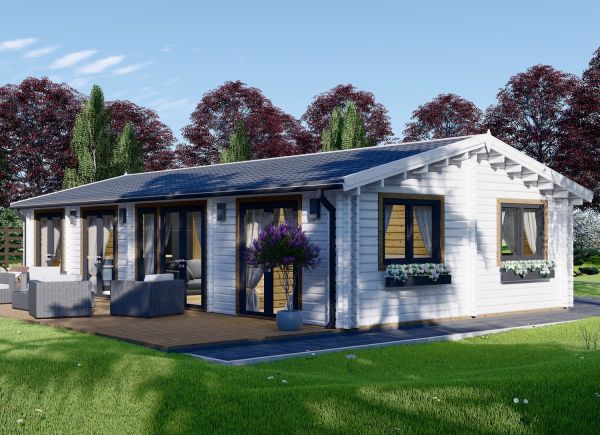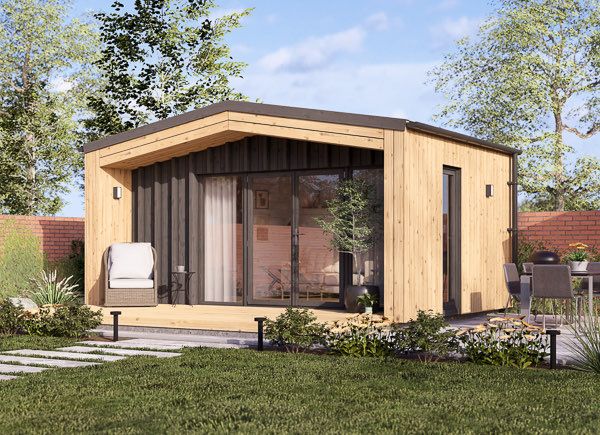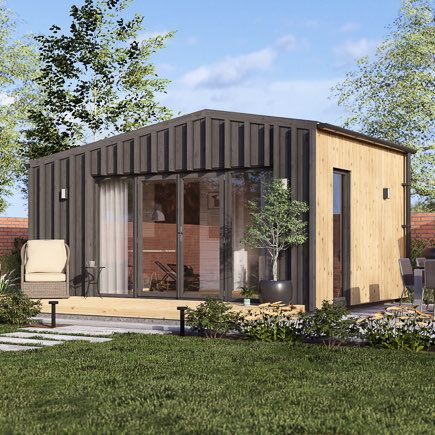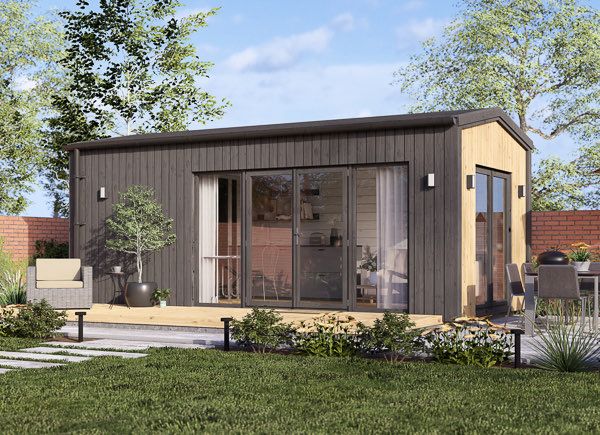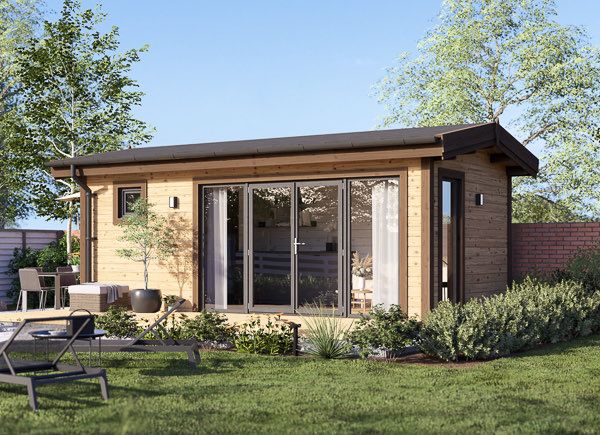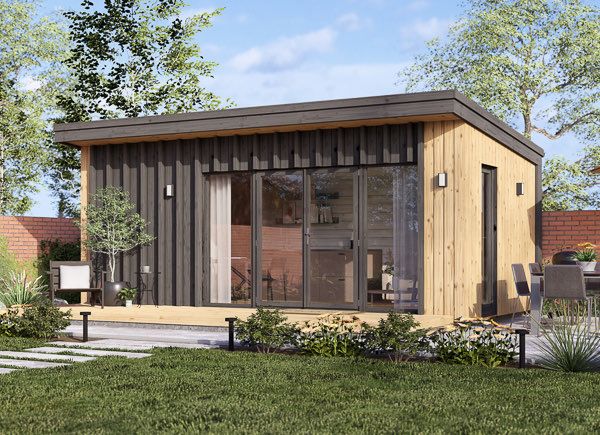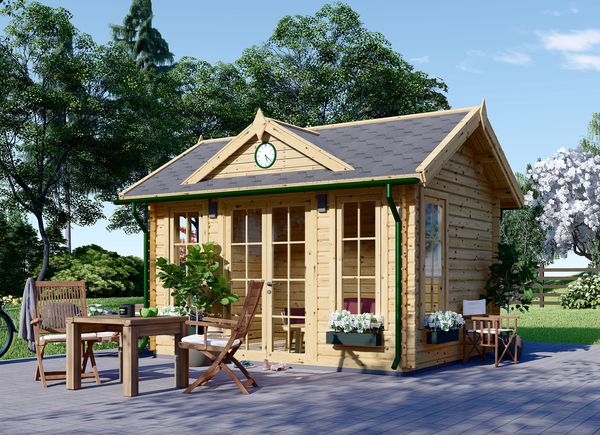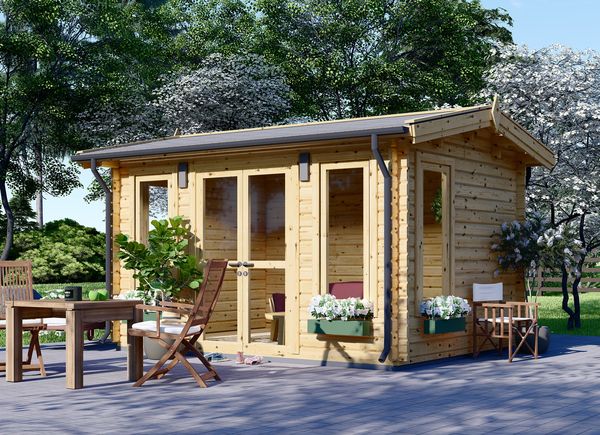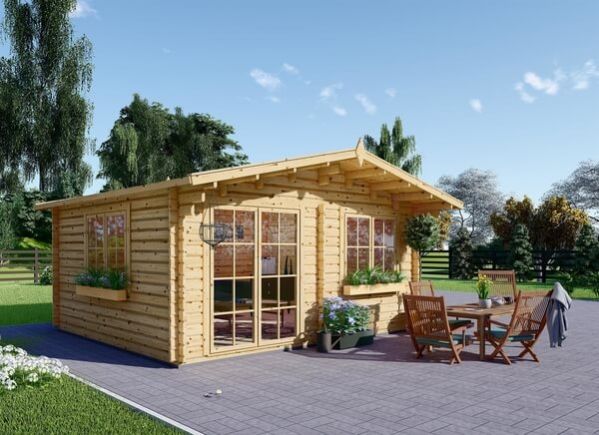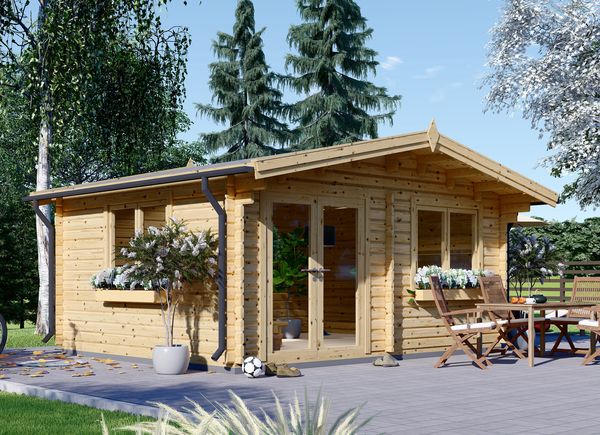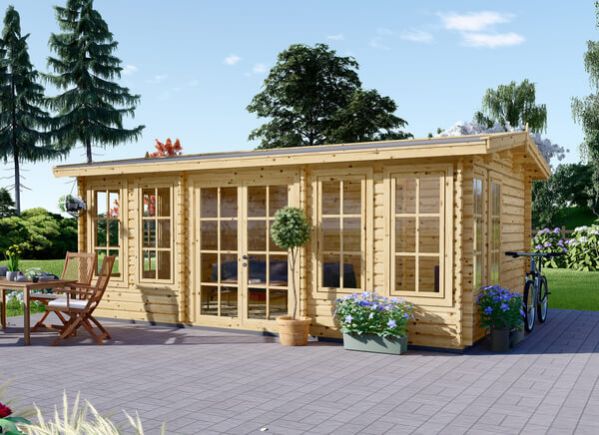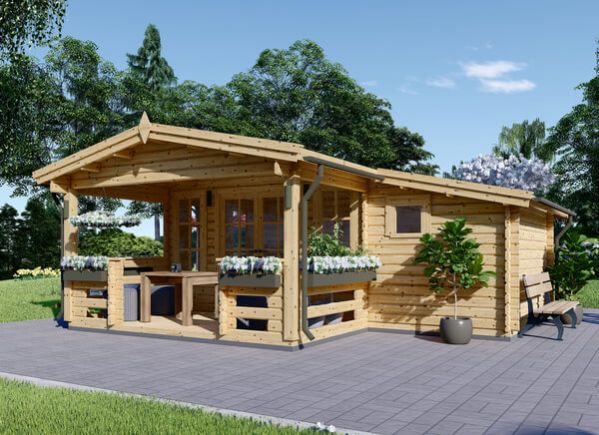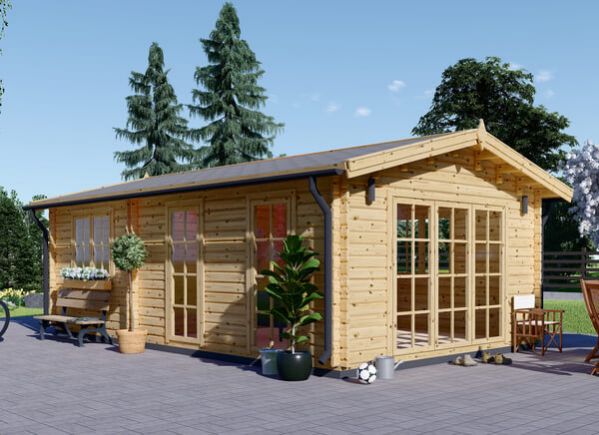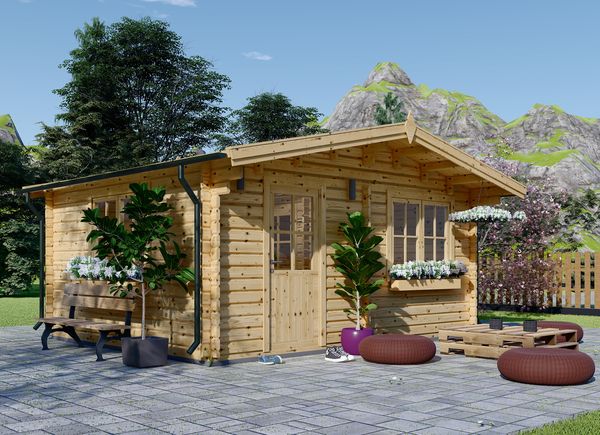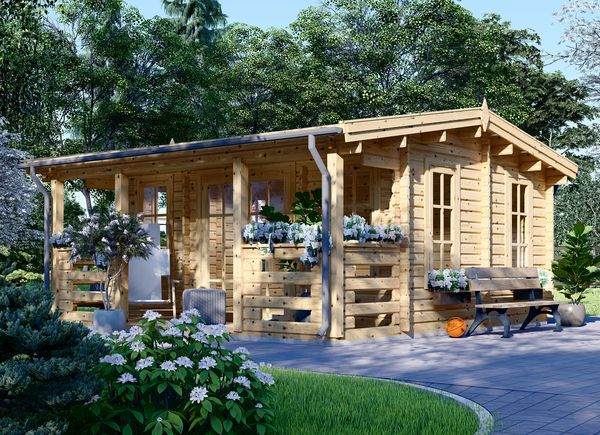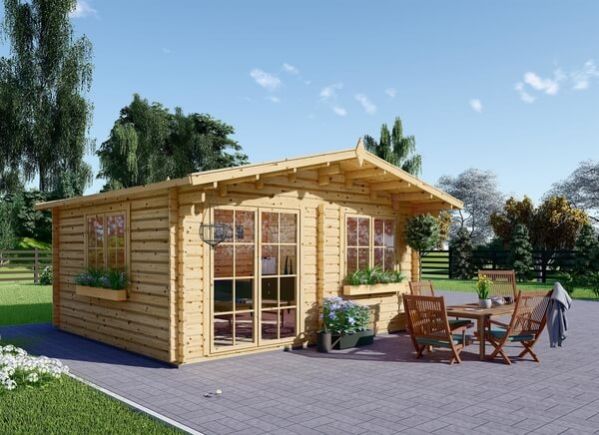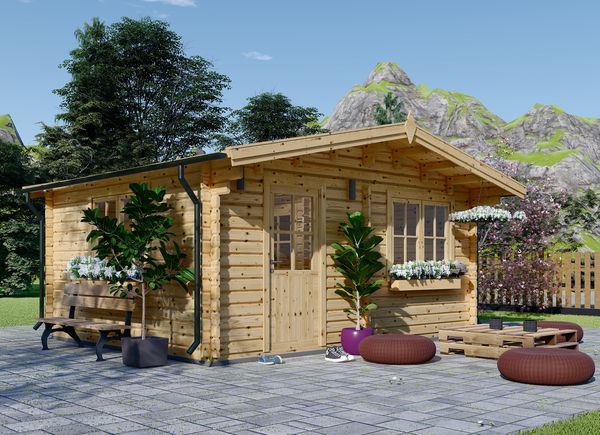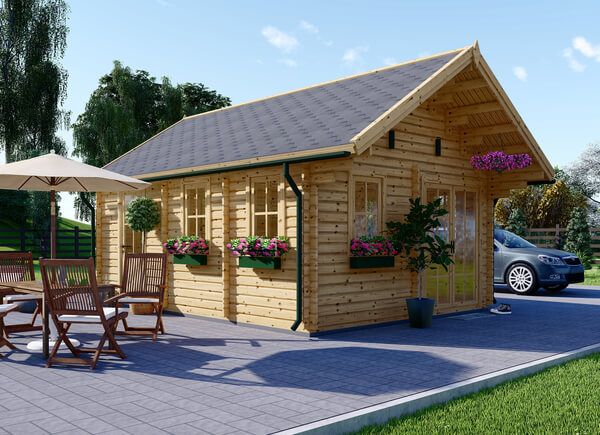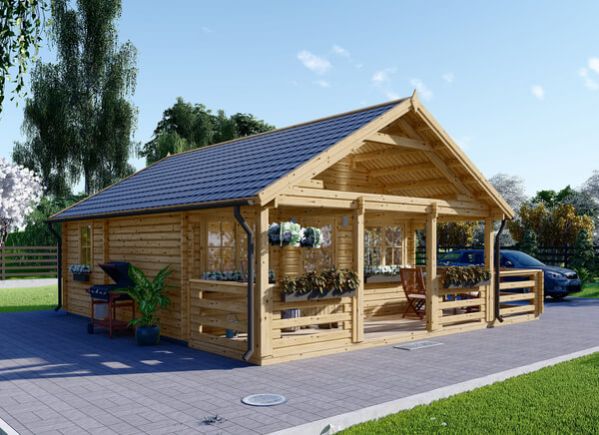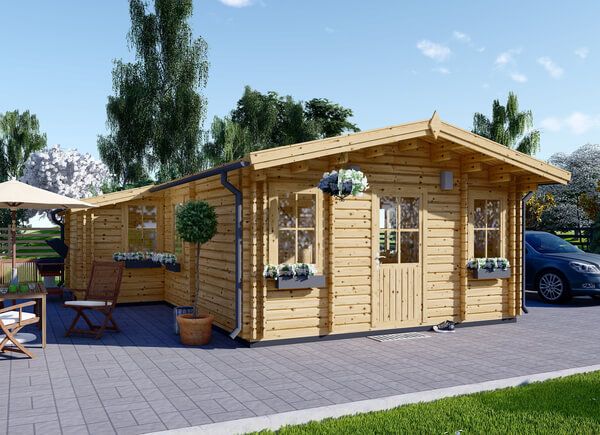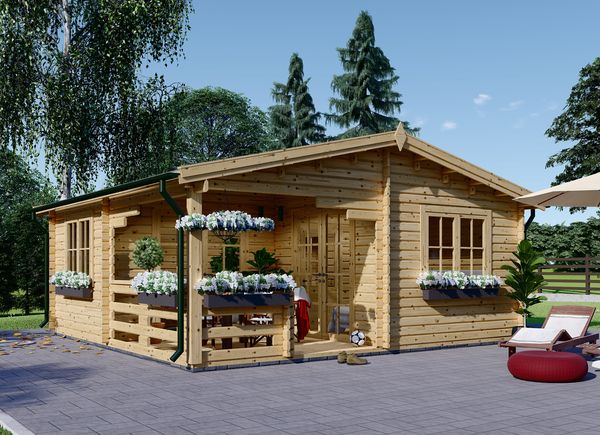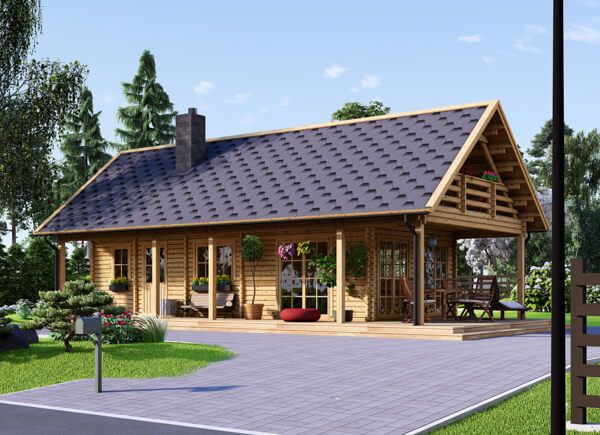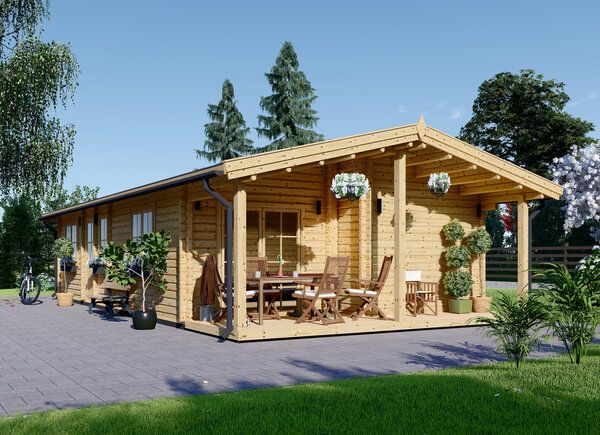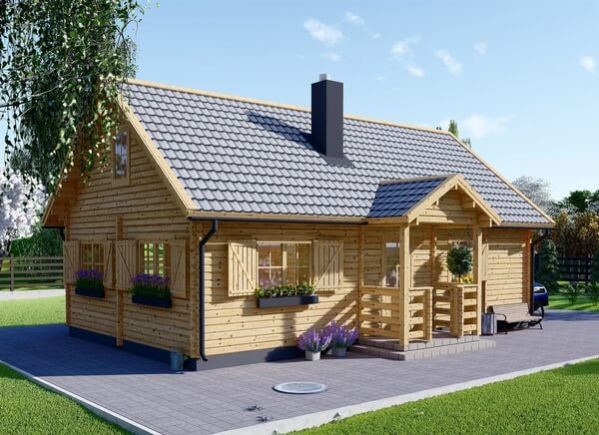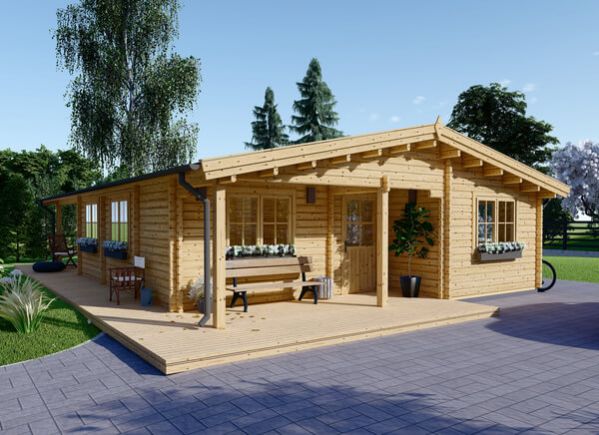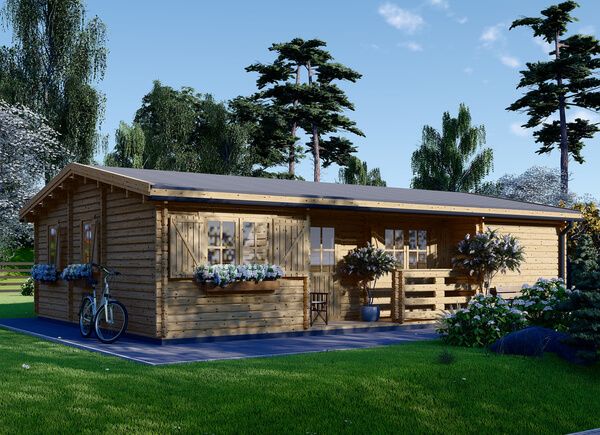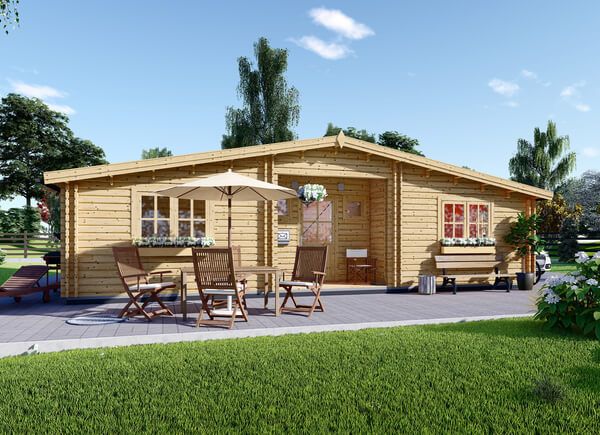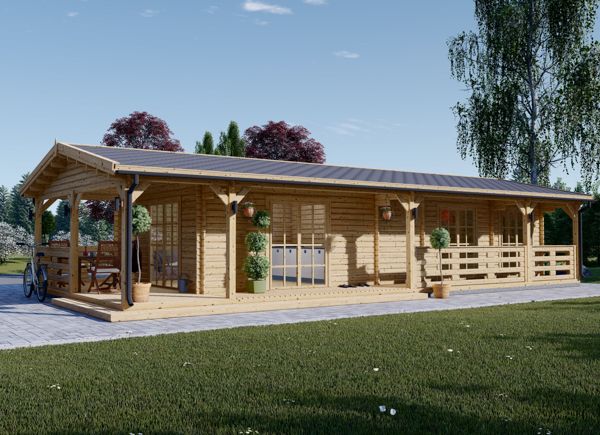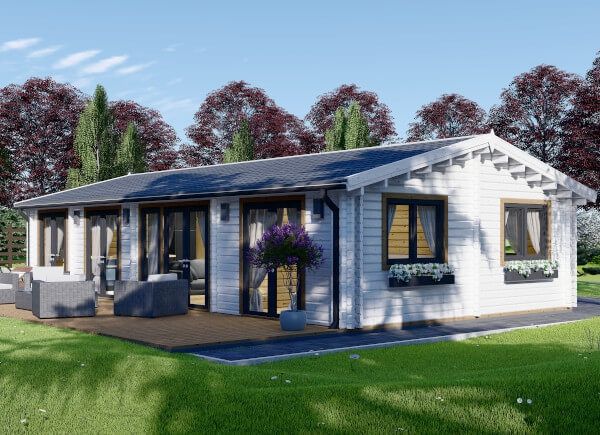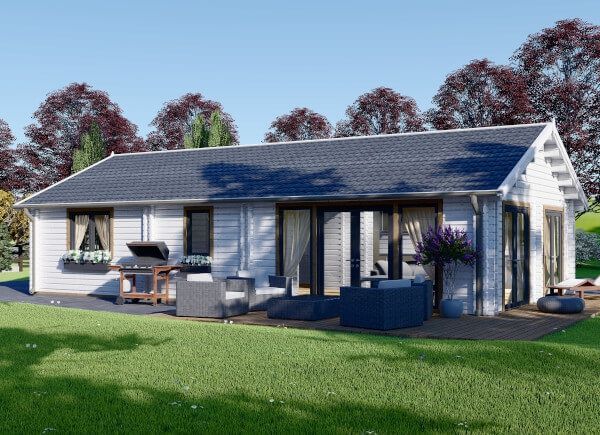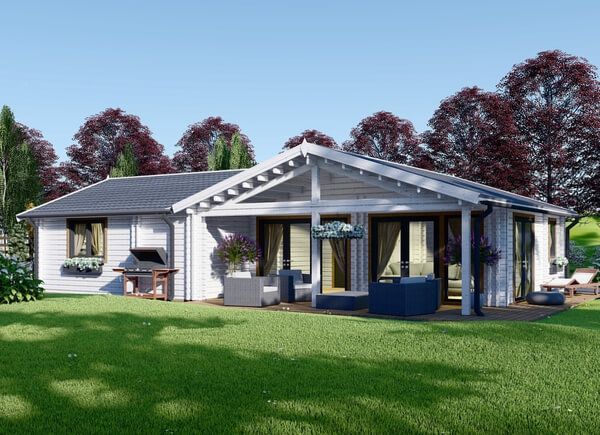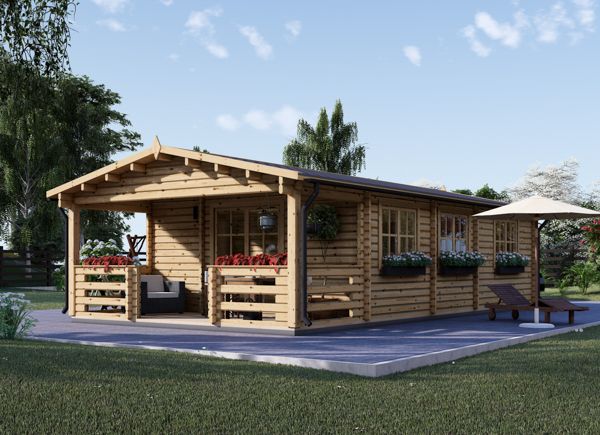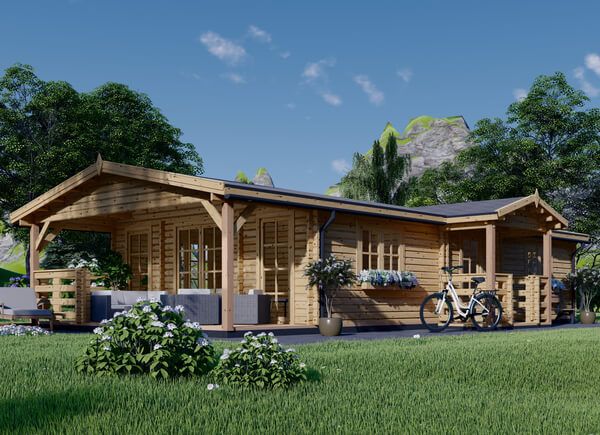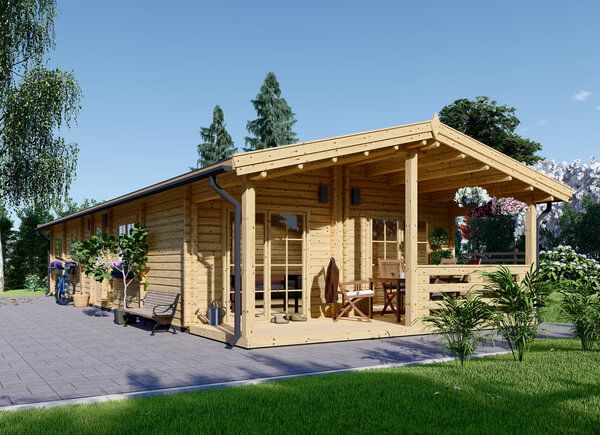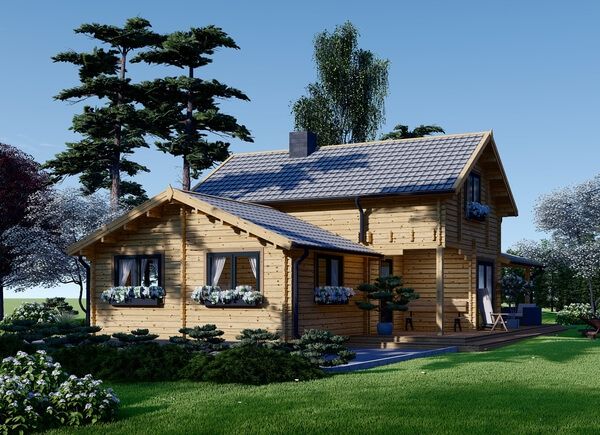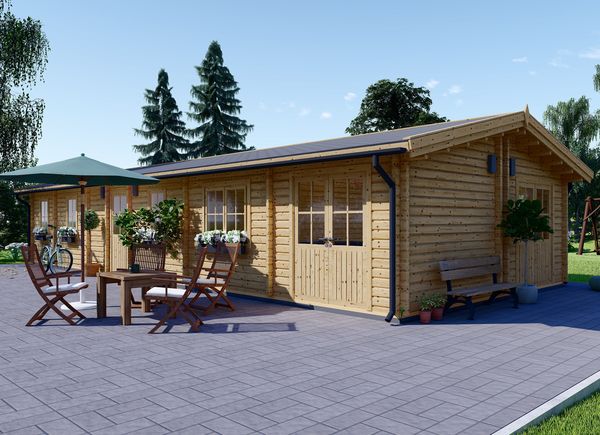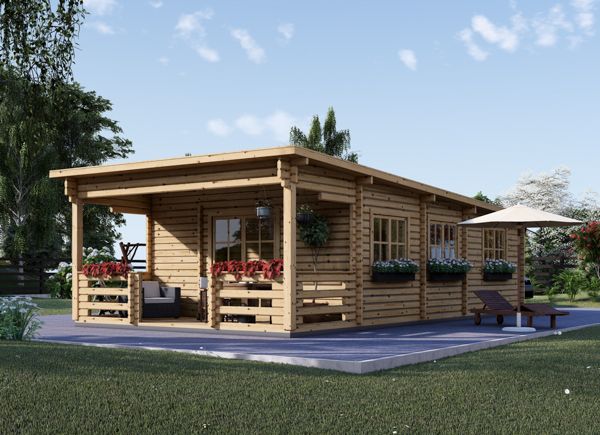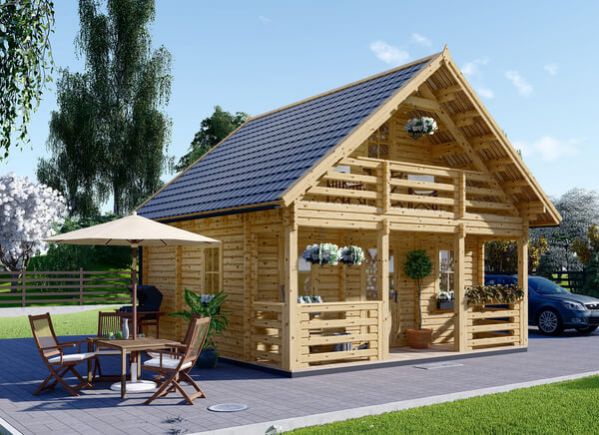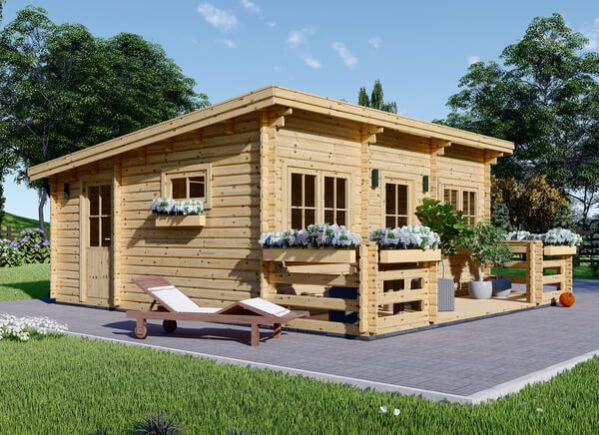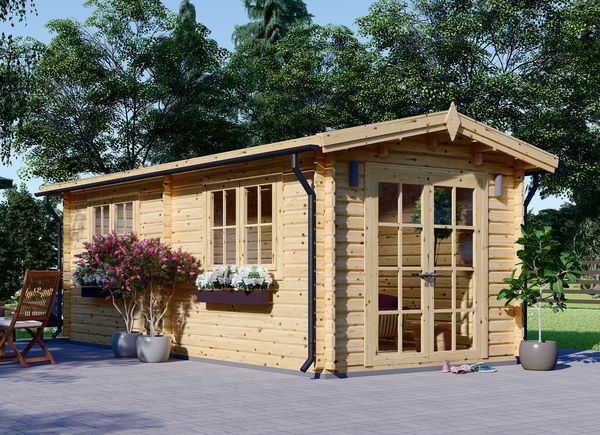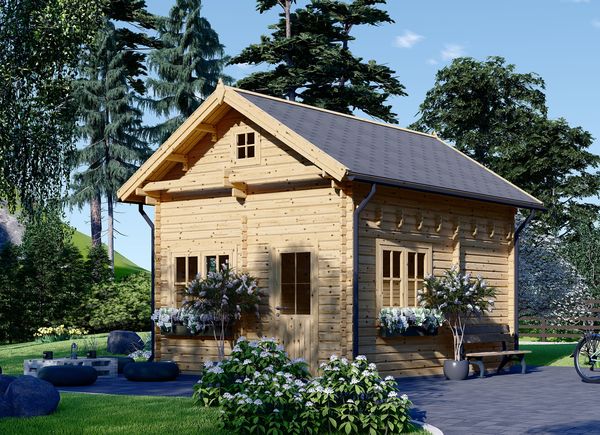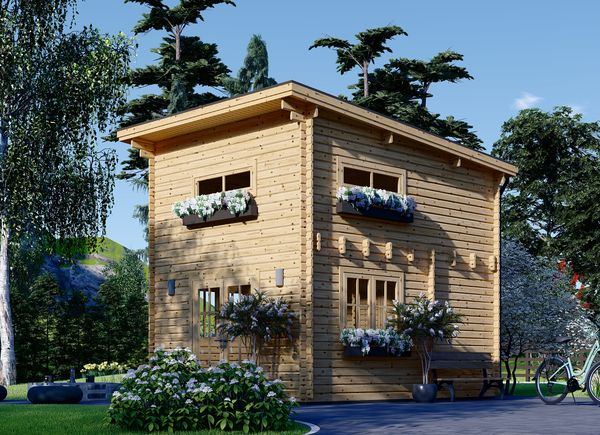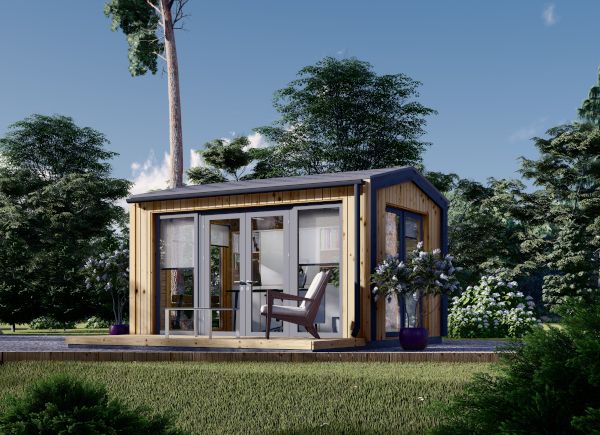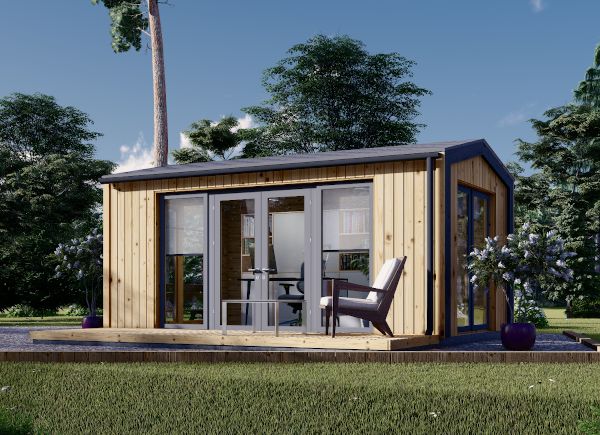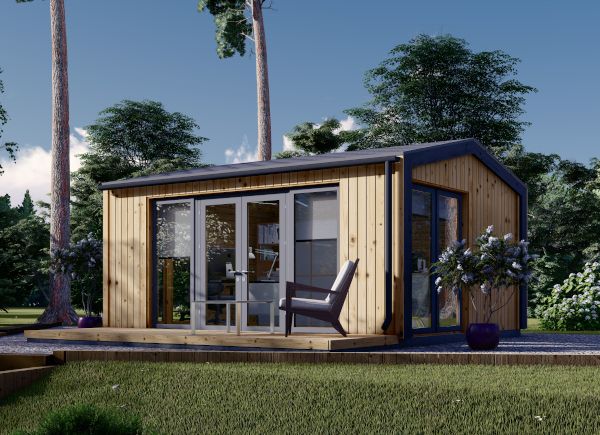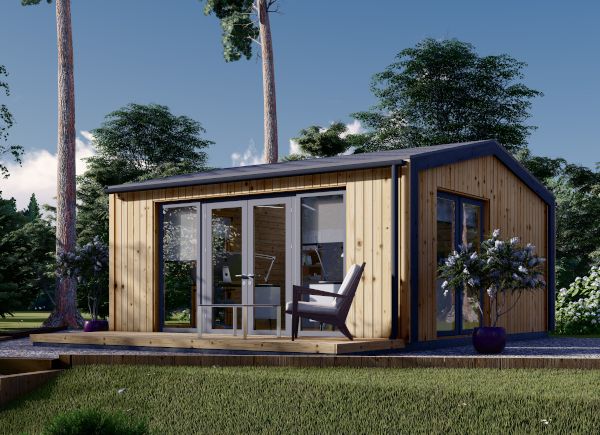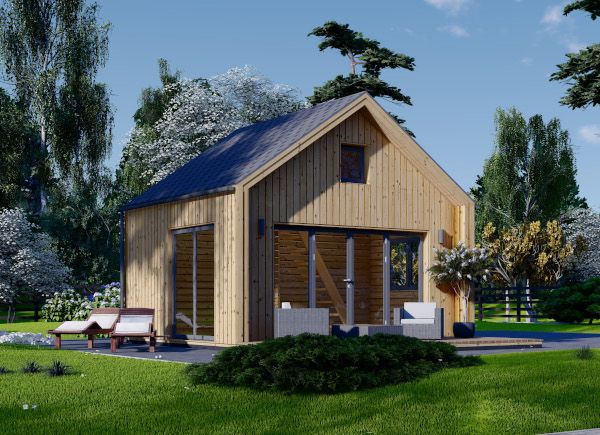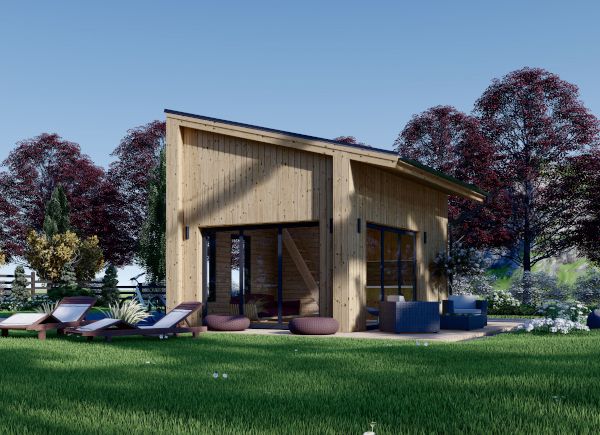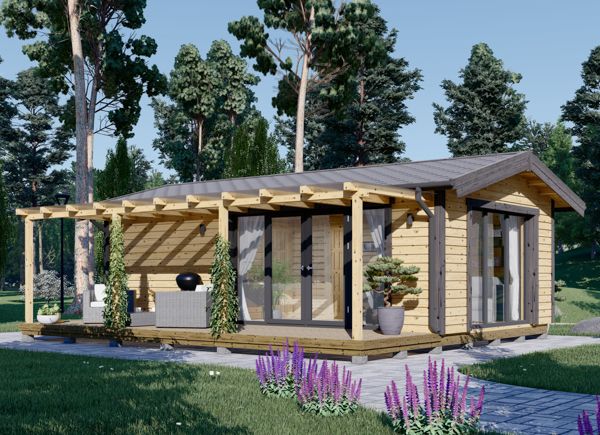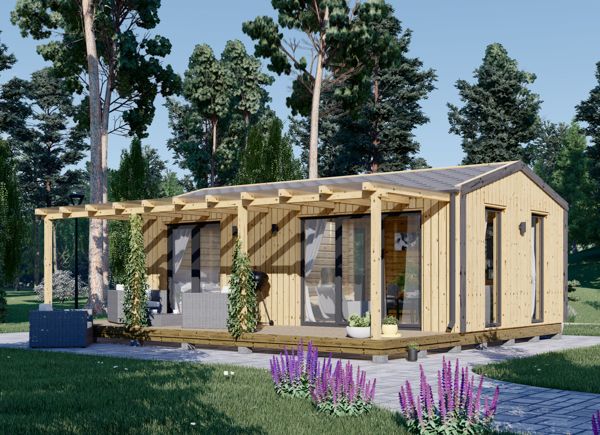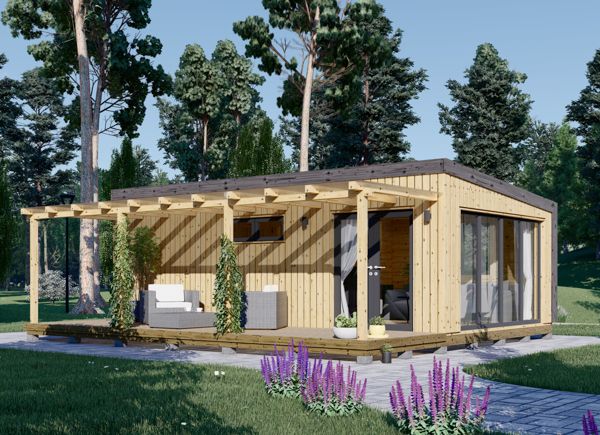Are you sure you want to perform this action?
Insulated Log Cabins
Selected
A spacious, modern 3-bedroom log cabin house AGNES S has been designed for you to enjoy the natural light and surrounding landscape. Four large double glass doors on the front side of the building ensure easy access to almost any room. AGNES S is a perfect accommodation for 4 or more people, ensuring that each resident has their own private space. The building’s main point of attention is a centrally located living room, providing enough space for cooking, lounging, dining and communicating with your loved ones. Besides, this model also features anthracite PVC windows and doors that are included in the price.
- 3 bedrooms
- Anthracite PVC windows and doors
- Residential grade insulation level
Special Price: £39,585.00
Cosy, functional, and incredibly sleek – that's PIA PLUS for you! With 2 rooms inside and a terrace to comfortably lounge on, the hours will go by unnoticed. The beautiful double-pitched roof will provide a nice shade and a pretty sight, adding character to the structure. Moreover, the double doors will provide ample space to move and bring your chosen furniture in. There's enough room for a kitchenette, and the area next door provides space for a bathroom. Put your feet up with style and grace in PIA PLUS!
- Stunning vertical cladding with decorative details
- A terrace with an option to extend it
- Thermally insulated
£10,862.00

Provide us with details about it. We'll be happy to help!
Write Us A MessageTONIA PLUS is both harmony and contrast in one. We're delighted to introduce the beautiful and detailed facade that offers both privacy and natural light for the rooms inside. Speaking of, there are 2 areas to furnish – a possible lounge with a dining spot, and a bathroom with space for a shower. This modern construction is light and airy, plus, if you choose to add the optional terrace, you'll have even more chances to enjoy it. Hopefully, the wish will come naturally!
- An intriguing design with beautiful vertical cladding
- An effectively planned layout
- Thermally insulated
£10,514.00
Featuring a cosy and elegant structure and providing you with the freedom to create the space of your dreams, this is our EMMY PLUS, a practical prefabricated building, incorporating the best of both worlds – classical and contemporary. Enjoy plenty of natural light inside, which will follow any activity of your choice.
- Compact and functional
- A dedicated bathroom zone
- Superb remote office or garden lounge room
£10,530.00
Imagine yourself spending undisturbed time in your personal leisure oasis. We have designed ARTUR PLUS to become your wonderful place to unplug from the outside world and gather yourself together again. Alternatively, you could utilise this building as your remote workspace, ensuring ergonomic comfort and complete silence, which can notably increase the efficiency of your work. A nice shaded outdoor area is achieved with the roof overhang, which can be complemented with an optional terrace.
- Exceptionally bright and cosy
- Dedicated bathroom area
- Thermally insulated
£11,241.00

Provide us with details about it. We'll be happy to help!
Write Us A MessageThe unpretentious EVELIN PLUS can offer a wonderful retreat to any family looking to make their free time count. Under the flat roof lie 2 rooms, creating enough space for entertainment, me time, and more. In EVELIN PLUS, there's no rush to slowly enjoy your life, especially since you can convert the smaller room to a functional bathroom with a shower. What is more, the ability to add a terrace gives you even more options for how you'd like to spend your time in this stunning structure. This model is compatible with joyous occasions and the day-to-day too!
- Ultra modern look
- 2 rooms, including space for a bathroom
- Thermally insulated
£11,224.00
- Thermally insulated
- Superb lounging spot
- Compact and cosy
£6,976.00
- Thermally insulated
- Perfect for a hobby room or storage
- Double glazed windows and doors
£6,757.00
- Thermally insulated
- Spacious and bright
- Stylish roof overhang
£7,678.00
- Thermally insulated
- Bright and cosy
- Double glazed windows and doors
£7,030.00
- Thermally insulated
- Compact, cosy and bright
- Classical shape & design
£8,425.00
- Thermally insulated
- Lots of natural light inside
- Cute, minimalistic, and cosy
£9,329.00
- Thermally insulated
- Bright and cosy
- Multifunctional solution
£10,249.00
- Thermally insulated
- Size options: 5x4 ; 6x6
- Double glazed windows and doors
£9,206.00
- Thermally insulated
- Unique architectural shape
- Stylish little porch
£10,132.00
- Thermally insulated
- Minimal and compact
- Lots of natural light inside
£9,535.00
- Thermally insulated
- Compact, cosy and bright
- Classical shape & design
£10,649.00
- Thermally insulated
- Multifunctional solution
- Bright and spacious
£9,591.00
- Thermally insulated
- Exceptionally bright internal area
- Highly multifunctional space
£10,679.00
- Thermally insulated
- 7 m² covered terrace
- 2 separate indoor spaces
£11,385.00
- Thermally insulated
- Roof overhang serving as a pergola
- Bright, spacious & cosy
£9,031.00
Compact, welcoming, and cosy wooden house MAX M seems to be specifically created to become your favourite lounging space in the garden, allowing you to admire the beauty you’ve created in your surroundings. It could even transform into a temporary accommodation for your guests or family members visiting for the weekend. If properly insulated, such a house could serve as an independent living space as well.
Important: this mobile cabin home meets all the requirements of the 1968 Caravan Act – therefore, no Planning Permission is usually required if you want to build it within the garden of your existing dwelling to be used as an extra space next to the main house. However, we highly recommend checking with the local planning department before installing it.
- Thermally insulated
- 3 separate spaces
- Bright and cosy
£22,671.00
- Thermally insulated
- Also available in 6x6m
- Dedicated bathroom space
£11,842.00
- Cosy covered terrace
- Lots of natural light inside
- Insulated version available
£11,801.00
- Thermally insulated
- Compact, cosy and bright
- Classical shape & design
£13,036.00
- Thermally insulated
- Spacious and bright
- Stylish roof overhang
£12,250.00
- Thermally insulated
- Also available in 5x5m
- Dedicated bathroom space
£15,441.00
- Thermally insulated
- 11 m² covered terrace
- Light-filled internal space
£12,330.00
- Thermally insulated
- Size options: 5x4 ; 6x6
- Double glazed windows and doors
£14,098.00
- Thermally insulated
- 10 m² loft as a bedroom space
- Stylish roof overhang
£17,236.00
- Thermally insulated
- 13 m² loft as a bedroom space
- Extraordinary 19 m² terrace
£23,035.00
- Thermally insulated
- Available with a flat roof
- A lovely 9 m² terrace
£15,087.00
- Thermally insulated
- Three separate rooms
- 18 m² living and dining space
£19,675.00
- Thermally insulated
- Compact, functional, and cosy
- 8 m² covered terrace
£15,897.00
- Thermally insulated
- 1 bedroom
- 20 m² covered terrace
£19,921.00
- Thermally insulated
- 2 spacious bedrooms
- Superb covered terrace
£42,575.00
Discover a classical style wooden house ARGO M and enjoy minimalistic wooden aesthetics in your surroundings. This highly functional, comfortable and practical model could provide you with a valuable living space extension close to your primary residence or, if reliably thermally insulated, could serve you as an all-year-round family vacation spot.
Important: this mobile cabin home meets all the requirements of the 1968 Caravan Act – therefore, no Planning Permission is usually required if you want to build it within the garden of your existing dwelling to be used as an extra space next to the main house. However, we highly recommend checking with the local planning department before installing it.
- Thermally insulated
- 8 m² terrace for outdoor lounging
- A perfect residential space extension
£27,603.00
- Thermally insulated
- 2 spacious bedrooms
- 2 balconies on the opposite sides
£41,883.00
Single-storey mobile house MEGAN M, covering 60 m² of internal space, including a charming, covered terrace, is a compact and cosy wooden solution, providing the required qualities to become one’s comfortable living space. If you want to stay warm and comfortable in this wooden beauty all year round, choosing an insulated version is a must! Conifer timber has natural insulation properties – upgrade it with an additional thermal insulation package and never look back!
Important: this mobile cabin home meets all the requirements of the 1968 Caravan Act – therefore, no Planning Permission is usually required if you want to build it within the garden of your existing dwelling to be used as an extra space next to the main house. However, we highly recommend checking with the local planning department before installing it.
- Thermally insulated
- Stylish 8m² covered terrace
- 24 m² living room area
£39,018.00
Has your house been feeling cramped lately? Building a living space extension in your backyard could save you a lot of hassle when you need some extra room for yourself, visiting friends or a comfortable place of residence for your family members to stay nearby. Wooden house LINCOLN M features a spacious living room area, two mid-size bedrooms, a dedicated bathroom area, and an additional compact space for storage.
Important: this mobile cabin home meets all the requirements of the 1968 Caravan Act – therefore, no Planning Permission is usually required if you want to build it within the garden of your existing dwelling to be used as an extra space next to the main house. However, we highly recommend checking with the local planning department before installing it.
- Thermally insulated
- 2 bedrooms
- Spacious and practical
£44,625.00
- Thermally insulated
- Spacious and cosy
- Two bedrooms
£41,842.00
- Thermally insulated
- Exceptionally spacious and functional
- 2 bedrooms
£33,805.00
- Thermally insulated
- 3 bedrooms
- Spacious covered terrace
£36,677.00
- Thermally insulated
- 3 bedrooms
- 44 m² living area
£41,914.00
- Thermally insulated
- 2 bedrooms + one spare room
- 23.5 m² living room area
£29,689.00
- Thermally insulated
- 2 bedrooms
- Spacious & functional layout
£25,948.00
- Thermally insulated
- 2 bedrooms
- Gorgeous 29 m² terrace
£31,771.00
- Thermally insulated
- 3 bedrooms
- Lovely 30 m² terrace
£32,486.00
- Thermally insulated
- 2 bedrooms
- 25 m² living room
£30,415.00
- Thermally insulated
- A huge 28 m² living room
- 2 spacious bedrooms
£42,748.00
- Thermally insulated
- Available with a flat roof
- 10 m² covered terrace
£21,509.00
- Thermally insulated
- 2 bedrooms
- 11.5 m² covered terrace
£28,498.00
Wooden house AVON with 11.5 m² covered terrace offers just the optimal amount of space for a mid-sized or larger family. If you want a spacious and comfortable family house, conveniently divided into numerous smaller spaces, definitely consider this model – it might be precisely the one for you!
Important: this mobile cabin home meets all the requirements of the 1968 Caravan Act – therefore, no Planning Permission is usually required if you want to build it within the garden of your existing dwelling to be used as an extra space next to the main house. However, we highly recommend checking with the local planning department before installing it.
- Thermally insulated
- 11.5 m² covered terrace
- 2 bedrooms
£55,772.00
- Thermally insulated
- 3 bedrooms
- Cosy 13 m² terrace
£52,051.00
- Thermally insulated
- 3-5 bedrooms
- Spacious 13.5 m² terrace
£51,288.00
- Thermally insulated
- 20 m² terrace and a large balcony
- 2 bedrooms
£50,801.00
One of our largest wooden house models – granny annexe BOSTON – could be the perfect secondary accommodation for your entire family and friends during cosy weekend stays or fun family celebrations. Due to its functionality and vast interior space, this gorgeous prefabricated building, made of natural conifer timber, have enormous potential of becoming your family’s summerhouse or even a primary living space. Spend valuable time together, surrounded by the best company, nature and fresh air.
Important: this mobile cabin home meets all the requirements of the 1968 Caravan Act – therefore, no Planning Permission is usually required if you want to build it within the garden of your existing dwelling to be used as an extra space next to the main house. However, we highly recommend checking with the local planning department before installing it.
- Thermally insulated
- Spacious covered terrace
- 30 m² living room
£69,175.00
- Thermally insulated
- 20 m² covered terrace
- Lots of natural light
£44,514.00
Our gorgeous mobile house BRIGHTON is well equipped with 2 or 3 bedrooms (depending on your internal layout arrangement), a living room, a separate kitchen, bathroom space and several additional smaller rooms which could serve you numerous purposes. Due to its vast space and superb internal layout, this house is a perfect base for large family gatherings or get-togethers with friends.
Important: this mobile cabin home meets all the requirements of the 1968 Caravan Act – therefore, no Planning Permission is usually required if you want to build it within the garden of your existing dwelling to be used as an extra space next to the main house. However, we highly recommend checking with the local planning department before installing it.
- Thermally insulated
- 2-3 spacious bedrooms
- Covenient internal layout
£58,356.00
- Thermally insulated
- 2 separate rooms
- Spacious and cosy
£12,124.00
- Residential grade insulation level
- 3 comfortable bedrooms
- Large 35 m² terrace (optional feature)
£105,291.00
Wooden house HYMER with a spacious 10 m² covered terrace is an excellent option for those looking for a relaxed family vacation space or a cosy place of residence for experiencing slow-living closer to nature. A beautiful terrace extends the inside area of the house and allows you to enjoy wonderful moments outdoors despite the weather conditions.
- Thermally insulated
- Version with an apex roof available
- 10 m² covered terrace
£21,876.00
Our two-storey wooden house LIVINGTON, featuring traditional wooden aesthetics and optimal space distribution, could serve you as a functional secondary residence or a cosy summer house. Its spacious covered terrace on the first floor and charming balcony on the second floor provide lots of space for convenient lounging outdoors. Enjoy the stillness, relaxation and experience the feeling of slow-living closer to nature.
- Thermally insulated
- Spacious and comfortable loft
- Compact and cosy
£24,994.00
A compact classical style wooden house ALTURA features a large living room combined with a kitchen space, a small bedroom for creating a separate sleeping area and a functional bathroom space. Due to its one-storey layout, ALTURA is a great choice for families with small children or elderly households. What is more, a beautiful 9 m² terrace is perfect for having delicious family meals and spending valuable time together outdoors.
- Thermally insulated
- Available with an apex roof
- A lovely 9 m² terrace
£15,879.00
- Thermally insulated
- Also available in 3x6m
- Fits in the narrow plot
£14,242.00
- Thermally insulated
- Also available in 3x10m
- Fits in the narrow plot
£9,498.00
A compact and functional wooden house AVIGNON features a cosy lounging area on the first floor and a comfortable loft space, perfect for arranging a comfortable resting zone on the second floor. If you are looking for a highly functional and budget-friendly wooden house, this model might be the right one for you.
- Residential grade insulation level
- Available with a flat roof
- 16 m² loft as a bedroom space
£25,893.00
A compact and functional wooden house AVIGNON features a cosy lounging area on the first floor and a comfortable loft space, perfect for arranging a comfortable resting zone on the second floor. If you are looking for a highly functional and budget-friendly wooden house, this model might be the right one for you.
- Residential grade insulation level
- Available with an apex roof
- 16 m² loft as a bedroom space
£17,697.00
- Thermally insulated
- Exceptional versatility
- Available in 12 m², 15 m², 20 m², 25 m²
£5,882.00
- Thermally insulated
- Exceptional versatility
- Available in 12 m², 15 m², 20 m², 25 m²
£6,723.00
- Thermally insulated
- Exceptional versatility
- Available in 12 m², 15 m², 20 m², 25 m²
£8,375.00
- Thermally insulated
- Exceptional versatility
- Available in 12 m², 15 m², 20 m², 25 m²
£9,522.00
- 15 m² loft as a bedroom space
- Delightful 10 m² terrace
- Efficient thermal insulation
£12,315.00
Modern and compact wooden house SOPHIA could not leave any contemporary style admirer indifferent. Featuring a spacious sleeping loft, a bathroom and a large terrace, this model is perfect for those wishing to have an eco-friendly and functional space for temporary visits or weekend stays. Its beauty lies in the wonderful forms and modern cladding solutions as well as large windows, letting all the beautiful sunshine in and brightening up your space.
- 15 m² loft space for comfortable resting
- Large 15 m² terrace
- Efficient thermal insulation
£14,882.00
- Horizontal timber cladding
- 1 bedroom & a spacious living room
- Efficient thermal insulation
£20,312.00
- Available with a flat roof
- 1 bedroom & a spacious living room
- Efficient thermal insulation
£18,604.00
- Available with a flat roof
- 1 bedroom & a spacious living room
- Efficient thermal insulation
£19,052.00

Provide us with details about it. We'll be happy to help!
Write Us A Message




 Log Cabins
Log Cabins

